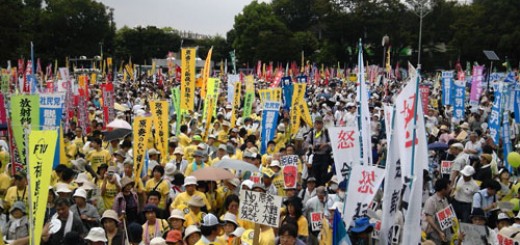Six Years after the Accident, Fukushima Increasingly Abandoned
On the 11th of March this year, a full six years passed since the nightmarish Fukushima accident occurred. Has the accident been explained? Has the number of victims stopped increasing? Has the future outlook for people’s livelihoods become clear? Will there never again be another nuclear accident? Unfortunately, the answer to all the above is “no.” The declaration of a nuclear power plant emergency issued at 7:03 p.m. on March 11, 2011, has not even been rescinded yet.
The sequence of events that led to the explosion of the Unit 1 reactor on March 12 is still not clear. How much hydrogen leaked, and by what path? Where did the explosion originate? Only Niigata Prefecture is continuing verification work by a technical committee open to the public. Even in the discussion on February 9 this year, TEPCO’s assertions had inconsistencies, and the company failed to answer questions from committee members, saying it would go forward with new investigations.
The Unit 2 reactor also underwent a meltdown, but from the outside it appears as if nothing happened. Nearly six years after the accident, TEPCO deployed a robot with a camera into the containment vessel on February 9. It measured high levels of radiation exceeding 600 Sv/hr. TEPCO played its ace on February 16, sending in its “scorpion” survey robot, but the robot encountered sediment blocking its path before it could reach the pressure vessel, managing to advance a mere two meters. (See News Watch pp. 10-11) for more details) Within the containment vessel, the level of radiation varies widely from 20 to 650 Sv/hr depending on location–if the measurements can be trusted for accuracy–but this indicates that debris containing various components has been scattered erratically. Plans for decommissioning the reactor will probably be greatly delayed.
Researchers are proceeding with studies on the composition of spherical particles containing cesium (cesium balls) originating from the accident. These particles were found in aerosols that reached Tsukuba, 170 kilometers away from the Fukushima Daiichi NPP. They are also being found in soil and waterways near the NPP. Within these vitrified particles measured in microns, they have found iron, zinc, chromium, rubidium, molybdenum, uranium and other elements. If the genesis of these balls can be elucidated, it might throw light on the causes of the accident and the processes involved. These cesium balls have exceedingly high radioactivity, of the order of 1011 becquerels per gram, and are a cause of concern regarding environmental contamination.
In the six years since the accident, how far have radiation levels decreased? Cesium-134 has a half-life of about two years, so 1/23 of it would be left, or about 13%. On the other hand, Cs-137 has a half-life of about 30 years, so about 87% of it remains. According to the Ministry of the Environment, 57 municipalities of seven Tohoku and Kanto prefectures will have completed their decontamination as of the end of March. If so, where did the 87% go? Radioactivity does not just disappear instantaneously through decontamination with no passage of time.
The entire town of Tomioka in Fukushima Prefecture became an evacuation zone after the nuclear accident. In response to a government proposal to rescind the evacuation orders for all areas aside from the “areas to where it is expected that residents will face difficulties in returning for a long time” on April 1 this year, a mere 16% of the affected households responded that they would like to return. The return rates to the five municipalities for which the orders were rescinded as of July last year are 11% for Naraha, 14% for Minamisoma, 9% for Katsurao, and 21% for Kawauchi, with only Tamura having a return rate as high as 72%. That is because only a small part of Tamura had been evacuated to begin with.
People who voluntarily evacuated from areas outside the evacuation zone are scattered throughout Japan. Fukushima Prefecture intends to cut off access this March to the free housing it had been offering to the 15,000 voluntarily evacuated households that had fled outside the prefecture as of December 2012. This is despite the lack of a rational basis for cutting them off. The standard of 20 mSv/year is nothing more than a criterion for times of emergency when there is nothing else that can be done.
At a citizen-exchange symposium on Priorities for a Global Sustainability Research Strategy, held by the Research Institute for Humanity and Nature on February 4 in Kyoto, the topic “What can we learn from the Fukushima nuclear accident experience and what should we communicate?” was rated the number one topic deserving research.
(Yukio Yamaguchi, CNIC Co-Director)

